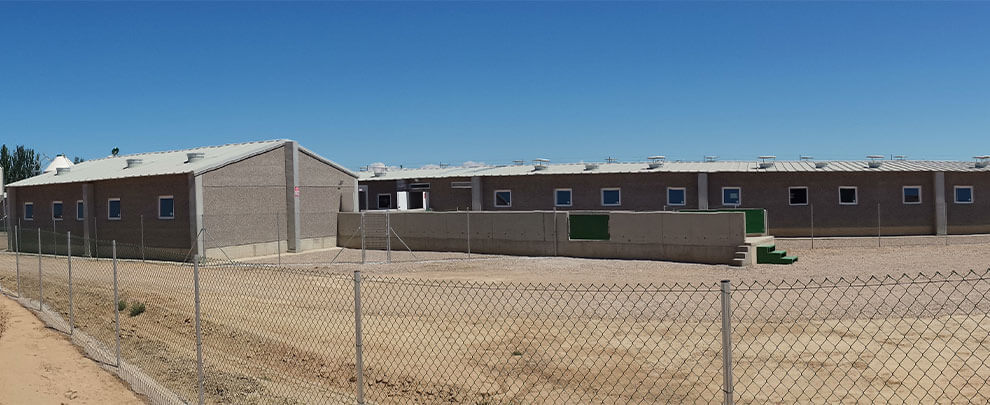Blog
Blog

Efficient biosecurity measures in a pig farm
26 of May of 20 - News
The pig sector has a series of biosecurity measures to protect farms from diseases, maintain a perfect sanitary status and, with this, reduce the use of antibiotics and achieve good production rates. Carlos Sánchez, veterinarian of the Animal Health Prevention Service of the Generalitat of Catalonia, assures that the sector is aware of the value of biosecurity, but, in turn, remembers that it is a constant figth and that we cannot lower the guard, especially at a time when antibiotic resistance is increasing and new outbreaks of disease appear to threaten our farms.

Carlos Sánchez, veterinarian of the Animal Health Prevention Service of the Generalitat of Catalonia. Photo: Carlos Sánchez.
How important is biosecurity on farms?
It is one of the key points within the management of farms, since it helps us to reduce the risk of infectious diseases entering and also the spread of these diseases within the same farm and to others. A good sanitary status of the animals implies a better performance and a lower expense in the consumption of medicines and antibiotics. On the other hand, it should be taken into account there are currently real threats of diseases that can enter our territory: part of the countries of Eastern Europe has outbreaks of African swine fever (ASF), and in countries of North Africa they have been registered cases of foot-and-mouth disease.
What is the current situation in the application of measures?
It is a situation that is constantly evolving and, luckily, it is getting better. However, I think that the concept of biosecurity should be a dynamic concept, we do not have to stop to get concrete measures and that's it. Such measures must be maintained over time and, depending on changes in our environment (weather conditions, the appearance of new diseases, trade flows, etc.), they must be updated and new ones created.
What are the main routes of disease transmission on farms?
I always propose to consider a vision from the outside to the inside, to imagine that we are at the entrance of our farm and we see that there is a whole group of viruses and bacteria that want to enter and that will do everything possible to do so. We are in the front line of combat and we have to protect the entry routes that are: the entry of new animals, vehicles, people (workers, veterinarians, other operators, etc.), feed, water and air. Then we have a second combat line, in which, when unfortunately the microorganisms have already passed the first line, we have to prevent them from spreading throughout the farm. For this we have to keep the margins of the buildings clean, put footbaths at the entrance of each ship, cover the openings so that the birds and rodents do not spread the disease, carry out a correct cleaning and disinfection of the pens, etc.
What are the minimum biosecurity measures that the administration requires to apply?
The basic mandatory measures are set out in Decree 40/2014, which includes:
- The establishment of minimum distances between farms, since a high density of farms increases the risk of spread.
- A perimeter fence (the door always closed). The farms must be closed to prevent the entry of wild boars and outsiders.
- A system that ensures the correct application of the disinfectant product on the wheels of vehicles entering the farm.
- The installation of systems that ensure that birds and other animals do not enter through openings, windows, doors or chimneys.
- To have facilities to prevent people from being a source of contagion. This implies having adequate changing rooms, clothing for the exclusive use of the farm, location of the changing room as close as possible to the entrance…
- New facilities should be designed so that feed and animal loads are made from outside the farm.
- It is important that workers have a basic knowledge of health, biosecurity and well-being.
- Correctly perform the tasks of cleaning and disinfecting facilities with the appropriate equipment.
- Have corpse storage and management systems that can be carried out from outside the perimeter fence.

Farms must have adequate changing rooms. Photo: Rotecna.
What does non-compliance with these measures entail?
Firstly, a risk for the farmer himself, since his farm is exposed to the possible entry of diseases; But not only that, it also increases the risk that the farm will become a kind of center for the multiplication and diffusion of these pathogens and may affect other farms that do apply biosecurity measures. On the other hand, if a farmer does not comply with the minimum measures, there are controls and inspections to detect it, and in that case, the regulations contemplate sanctions that can range from a warning to the farmer to the imposition of time limits to adapt their facilities. or prohibit the entry of animals on the farm while it is not in condition.
Are there any additional measures that are already in place?
Yes. In fact, in Catalonia a few years ago it was established that all pig farms must pass a biosecurity survey, which includes a series of additional measures that some farms are already applying, such as, for example: having a double perimeter fence ; install HEPA filters (high efficiency particle air) in the air inlets of the buildings, since they greatly reduce the entry of pathogens through the air; have an independent path to the access to the farm for the carcass collection vehicle and for the slurry removal vehicle…
What advantages does biosecurity bring?
There is a very logical sequence: biosecurity helps to decrease the appearance of diseases, which implies healthy animals that will produce more and better, and a higher performance of the farm. In addition, having healthier animals implies less use of antibiotics and a reduction in spending on them. On the other hand, another important aspect is the valuation of the farm. A farm has a value that can be increased with the application of biosecurity measures, which can benefit you if in the future you want to rent the farm, do business with a commercial, etc.
What is the trend of the sector in this area?
We are optimistic, because we are verifying that the farms comply with biosafety and, above all, that there is an awareness of the sector. The proof is that both the sector and the administrations increasingly self-demand more in this area, since we cannot lower the guard. The trend is to ensure that all pig farms achieve the highest possible level of biosecurity.






